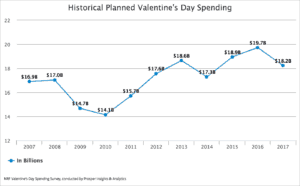Love is a many splendored thing indeed, especially if you’re a retailer on Valentine’s Day. Celebrated in several countries throughout the world, the uncertain origin of the holiday dates as far back as 270 AD in Christian folklore. Though many attribute the first mention of it as a day of celebration to the English poet, Geoffrey Chaucer, whose romantic verses prompted the exchange of gifts and notes between English couples. But under the guise of noble legends, covered in chocolate hearts and labeled with affectionate notes, it’s hard not to be cynical about a love-inspired holiday that, according to the National Retail Federation (NRF), will generate $18.2 billion in sales within the US this year.
Love may be the universal language, but money makes the world go round


The meet-cute of tradition and technology
The concept of capitalizing off love expands far beyond the U.S. to numerous countries who pay homage to ardor once a year, though the calendar date may change. For each of these countries, a similar group of verticals serve as traditional, go-to gifts which see a spike in sales during this time.
In the UK, Valentine’s Day spending for 2017 is expected to reach £700 million, or more than $874 million USD, with engagement rings, lingerie and flowers topping the list of highest gifted products. However, data shows that buying behaviors are changing with the times and the holiday once considered solely for lovers has evolved to broadly include non-romantic love as well. Bing reported 20% of Valentine’s Day searches included the word “friend” and 15% of women reported they plan to spend money on themselves this year. Spending on gifts for pets will reach the hundreds of millions. In the week before Valentine’s Day, online searches containing related keywords rise 55%.
Australia follows a similar pattern as the UK and the US, with lovers doting on each other in the form of fancy dinners, lush bouquets and decadent chocolates on February 14. Online merchants Edible Blooms and Beer Cartel partnered together and surveyed more than 1800 Australians regarding their buying patterns for the holiday, using the chance to win a holiday prize bundle as an incentive. 80% of couples felt favorably towards the holiday and concurred that celebrating the holiday had a positive effect on their relationship. Findings also showed alcohol among the top three gifts for men and flowers as the leading purchase for women.
India takes Valentine’s Day a step further with a series of celebrated days in the week leading up to February 14. Each day represents a different way to express love:
- Rose Day – February 7
- Propose Day – February 8
- Chocolate Day – February 9
- Teddy Day – February 10
- Promise Day – February 11
- Hug Day – February 12
- Kiss Day – February 13
- Valentine’s Day – February 14
Their ecommerce growth rate gained momentum with six million new entrants last month, creating a whole new pathway for merchants and consumers to connect.
China’s version of Valentine’s Day is known as the Qixi Festival and is celebrated on the seventh day of the seventh lunar month in the Chinese calendar, often falling in the month of August. At festival time women pray to find good husbands and the gifts exchanged are similar to other countries: flowers, candy and fancy dinners.
But China’s most impressive, economic phenomenon began in 2009 when ecommerce giant Alibaba Group created Single’s Day as a means to increase sales. The anti-Valentine’s Day holiday began as a joke in the 90s and occurs on November 11 each year, the date chosen to resemble two lone sticks meant to indicate singles. As the biggest global shopping day in the world, Single’s Day dwarfs Black Friday and CyberMonday in the US with sales reaching $1 billion during the first five minutes in 2016 and finishing with approximately $20 billion by the end of the day.
Fewer people may be celebrating Valentine’s Day this year and sales are expected to decline, but as long as love lingers in the air there will be a market for jewelers, candy-makers, florists and restaurateurs. Those who manage to incorporate an online and social media presence stand to gain the most.










